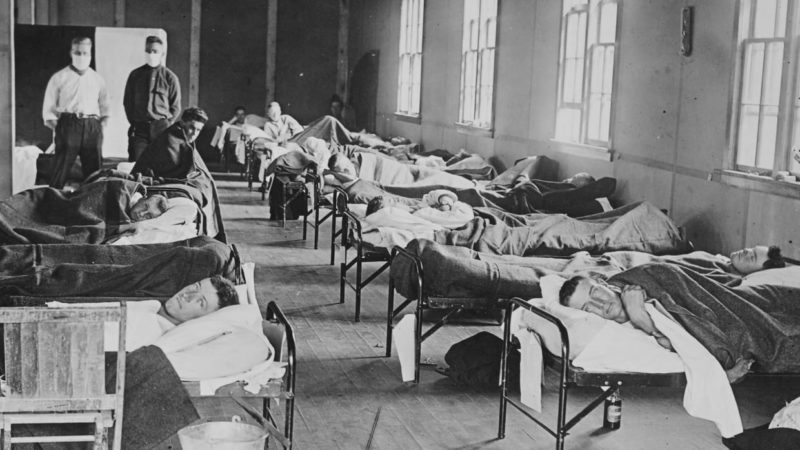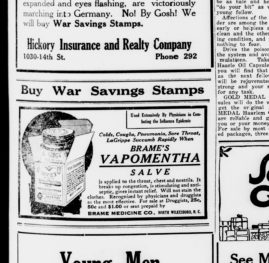DAVIDSON HISTORY
The “Spanish Lady” Visits Davidson: The Spanish Flu Epidemic of 1918-1919

Flu Sufferers at Colorado Agricultural College from history.com.
The coronavirus pandemic is far from the first epidemic to strike Davidson. Starting in the summer of 1918 and ending in the spring of 1919, an epidemic of what is usually referred to as the Spanish Influenza (caused by the H1N1 type A virus) claimed 700,00 victims in the United States and 13,644 in North Carolina. Many more were infected. Reports of the flu are very similar to what we are experiencing today.
News of the flu began spreading in August. According to the August 13 edition of the Abbeville Press and Banner, the epidemic was “spreading through Europe. 600 have died in London in the last 2 months. Spanish ‘flu’ in its symptoms is much like what the Americans call grippe. But it is more severe and often fatal.”
With World War I raging, the outbreak was especially severe in the military. According to the September 26 edition of the Wilson Daily Times, there were 23,000 cases of flu in U.S. army camps. 390 victims there later got pneumonia, which was responsible for almost a third of the deaths in the camps. On September 19, 1918, the High Point Review published U. S. Surgeon General Rupert Blue’s description of the disease: “People are stricken on the streets, while at work in factories, shipyards, offices or elsewhere. First there is a chill, then fever with temperature from 101 to 103, headache, backache, reddening and running of the eyes, pains and aches all over the body and general prostration. Persons so attacked should get to bed.”
By early October, the flu had reached Charlotte. On October 2, there were 100 new cases, with 160 on October 3 and 170 on October 4. The outbreak was worsened by the presence of Camp Greene, where 29,000 recruits were being trained to fight in World War I, on the edge of the city. The first death there occurred on September 13, and on October 4, the camp was sealed off for five weeks. By October 6, over seven thousand soldiers there had been infected, and ten had died. Charlotte instituted a ten-day quarantine, later extended, on October 5. While theaters, restaurants, churches, and schools were closed, stores were exempt from the order. A week later Charlotte newspapers, in a burst of unfounded optimism, reported that the city had beaten the disease.
By October, the flu had also reached Davidson. Cornelia Shaw reported in her history of the college that the south wing of Chambers Building, then a dormitory, was turned into an infirmary for the over 200 victims, and school was suspended for three weeks. On October 9, the Davidsonian reported that “Davidson College has had a severe visitation of Spanish influenza, and everyone on the campus at least, ought to be thankful that it is not a dangerous disease…But it was not beyond the management of the four trained nurses, and the Davidson ladies of the Red Cross, by whose kind help and succor the suffering has been wonderfully alleviated…Too much praise cannot be given the ladies of the Davidson Red Cross Chapter who have worked unceasingly to provide for and attend to the sick…Mention should also be made of the work of Dr. Withers, who has been called upon very frequently to attend to new cases.”
On October 23, the Davidsonian reported that Rose Stevenson, one of the nurses who had come in to help with the epidemic, had died from pneumonia on October 14. Miss Stevenson had just completed her nursing training at Presbyterian Hospital, but according to the report, she “was an excellent nurse, and worked diligently in her unselfish endeavor to bring relief to her patients. She was regarded with the greatest respect and highest esteem by all who knew her, and it was deeply regretted when she contracted the illness that she was treating, necessitating her return to Charlotte. Shortly after her return she contracted a case of pneumonia, which proved fatal … She will be long remembered by those who knew her at Davidson. Her service will be remembered and appreciated, and the honor will be bestowed upon her that she deserved.”
There were also cases in the town of Davidson, and several teachers had returned from their teaching assignments across the state because the schools were closed. Elizabeth Grey, who had been attending Peace Institute (now Peace College) also returned due to the suspension of classes.
Also, one Davidson student had died by October 23. According to the Presbyterian of the South, freshman D.J. Currie, who had already “given promise of a bright and useful future,” had died. Despite his death and that of Rose Stevenson, “The college and thus far the town, as compared with other communities, have much to be grateful for in the way they have escaped the ravages of the epidemic of Spanish influenza, when the number of cases occurring …have been so many.”
There were also cases in the town of Davidson. According to the October 30 edition of the Davidsonian, “No Sooner had the Spanish influenza scourge been driven from the college campus than it selected the town of Davidson as its new field of activity. Within the past two weeks the epidemic increased with great rapidity, until it was found necessary to call upon the local Red Cross for assistance. The Red Cross responded immediately, securing two trained nurses, who were put at the disposal of the town council. Miss Hill, employed to take charge, made a survey of the village, not only taking in the mill district, but all surrounding localities, going as far as Sherrytown. Under her able supervision medicine, food and nurses were supplied to the needy. The mills saw the need of nurses, and secured another nurse, Miss McDade. The Red Cross handled approximately between 75 and 100 cases of sickness. With the same self-sacrifice and devotion that was shown in their work during the college epidemic, they took hold of the town situation, and not one single death occurred after their taking control, although several cases of pneumonia developed. There were five deaths resulting from pneumonia following influenza before the Red Cross took charge.”
By October 30, the situation in town was rapidly improving. According to the Davidsonian, “The crisis in the town has passed, and all are on the road to recovery. Only two families still have much sickness. The mills, however, will not open yet.” The quarantine remained in effect, “as all danger has not yet passed… In all there have been over one hundred and fifty cases since the nurses took charge… The ‘flu’ did its worst work among the negroes…There were three deaths among the negroes.” Miss Hill had left for the University of Indiana to help with the outbreak there, and Miss McDade was expecting to leave soon.
Whatever the situation in Davidson, the Wilson Daily Times reported on November 5 that there had been an increase in both cases and deaths in North Carolina. The state health department was warning of “the danger that may be anticipated from any relaxation on the part of the public.” Appeals went out for nurses to do relief work since in the emergency hospitals “the professional and volunteer nurses are beginning to give way under the strain and they must be replaced until the epidemic has abated.”
In early November, the Presbyterian church in Davidson resumed holding services. The same was true in Charlotte, where pressure from businessmen and church leaders resulted in the lifting of the quarantine on November 6. The quarantine at Camp Greene was lifted on November 11, allowing throngs of citizens and soldiers to gather in Charlotte to celebrate the end of World War I. Subsequently, cases began to skyrocket there. According to the Charlotte News,” There is general apprehension…that the lifting of the ban early in the week and the general resumption of public meetings has given rise to the setback in the epidemic conditions.”
On December 3, with cases rising, schools were closed for a week; this was later extended until after Christmas. Doctors were suggesting a new quarantine order, but according to the News, “the approach of the holiday season and the vast amount of shopping to be done, offers a serious consideration to officials…for it is recognized that anything that would hamper or interfere with Christmas shopping would be most serious both to the business man and the citizen.”

A newspaper advertisement for Brame’s Vapomentha.
Thus, Charlotte officials refused to issue a new order. These same officials had apparently been under-reporting the numbers of cases and deaths throughout the epidemic. According to revised figures published during a recent study of death certificates by the Charlotte Observer, there were over 200 new cases on both December 6 and December 7. These revised figures showed that by December 20, there had been 590 deaths in Charlotte with 80 in December alone.
On January 29, the Davidsonian reported the vital statistics for the village of Davidson in 1918. Davidson College had approximately 200 cases of influenza and around 18 cases of pneumonia. The town itself had had 179 cases and 30 cases of pneumonia. Deaths from influenza were not listed.
As in the case of Covid-19, there were many remedies, some of which had been around for years, advertised to relieve the symptoms of the flu. One was Brame’s Vapomentha Salve, which was to be put in the nostrils before going out in the morning and just before bed. Hill’s Cascara Quinine Bromide was also touted as a treatment. On May 30, 1919, the Hickory Daily Record published an advertisement for Dr. Pierce’s Golden Medical Discovery, a “vegetable tonic” containing neither alcohol nor narcotics. Noting that in the spring “people feel weak, tired, listless, their blood is thin, they have lived indoors and perhaps expended all their mental and bodily energy.” It is then that they “are apt to suffer from an attack of Influenza…Purify the blood and you can defy influenza.”
The outbreak continued during the spring of 1919, but in succeeding years the outbreaks were small and caused many fewer illnesses and deaths.
[Note: For more detailed information on the situation in Charlotte, where authorities consistently under-reported cases, see the article “The Big Lie,” published in the Charlotte Observer on April 12, 2020. For more on the epidemic at Davidson College, see the blog on the Archives and Special Collections website: https://davidsonarchivesandspecialcollections.org/aroundthed/recollecting-the-spanish-influenza-epidemic-of-1918-and-covid-19-in-davidson/]
Nancy Griffith
Nancy Griffith lived in Davidson from 1979 until 1989. She is the author of numerous books and articles on Arkansas and South Carolina history. She is the author of "Ada Jenkins: The Heart of the Matter," a history of the Ada Jenkins school and center.


